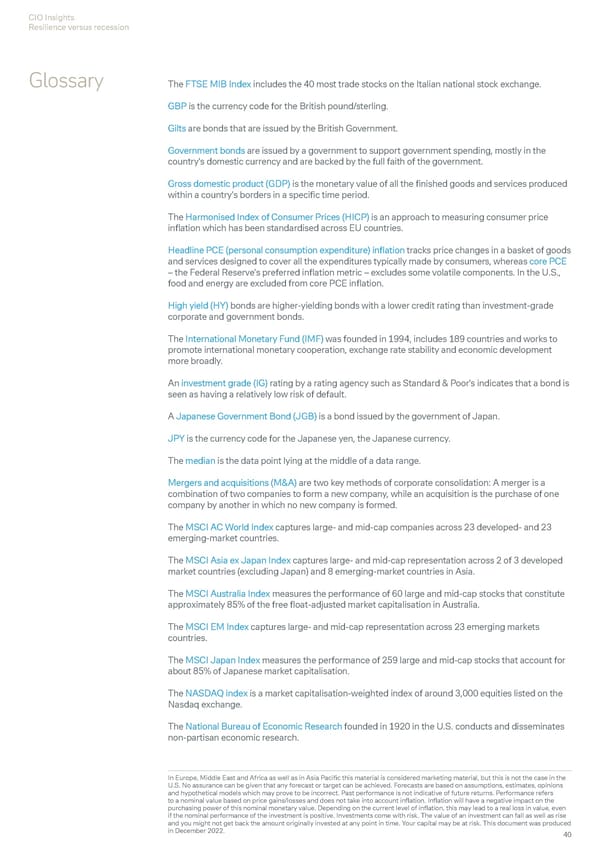CIO Insights Resilience versus recession Glossary The FTSE MIB Index includes the 40 most trade stocks on the Italian national stock exchange. GBP is the currency code for the British pound/sterling. Gilts are bonds that are issued by the British Government. Government bonds are issued by a government to support government spending, mostly in the country's domestic currency and are backed by the full faith of the government. Gross domestic product (GDP) is the monetary value of all the finished goods and services produced within a country's borders in a specific time period. The Harmonised Index of Consumer Prices (HICP) is an approach to measuring consumer price inflation which has been standardised across EU countries. Headline PCE (personal consumption expenditure) inflation tracks price changes in a basket of goods and services designed to cover all the expenditures typically made by consumers, whereas core PCE – the Federal Reserve's preferred inflation metric – excludes some volatile components. In the U.S., food and energy are excluded from core PCE inflation. High yield (HY) bonds are higher-yielding bonds with a lower credit rating than investment-grade corporate and government bonds. The International Monetary Fund (IMF) was founded in 1994, includes 189 countries and works to promote international monetary cooperation, exchange rate stability and economic development more broadly. An investment grade (IG) rating by a rating agency such as Standard & Poor's indicates that a bond is seen as having a relatively low risk of default. A Japanese Government Bond (JGB) is a bond issued by the government of Japan. JPY is the currency code for the Japanese yen, the Japanese currency. The median is the data point lying at the middle of a data range. Mergers and acquisitions (M&A) are two key methods of corporate consolidation: A merger is a combination of two companies to form a new company, while an acquisition is the purchase of one company by another in which no new company is formed. The MSCI AC World Index captures large- and mid-cap companies across 23 developed- and 23 emerging-market countries. The MSCI Asia ex Japan Index captures large- and mid-cap representation across 2 of 3 developed market countries (excluding Japan) and 8 emerging-market countries in Asia. The MSCI Australia Index measures the performance of 60 large and mid-cap stocks that constitute approximately 85% of the free float-adjusted market capitalisation in Australia. The MSCI EM Index captures large- and mid-cap representation across 23 emerging markets countries. The MSCI Japan Index measures the performance of 259 large and mid-cap stocks that account for about 85% of Japanese market capitalisation. The NASDAQ index is a market capitalisation-weighted index of around 3,000 equities listed on the Nasdaq exchange. The National Bureau of Economic Research founded in 1920 in the U.S. conducts and disseminates non-partisan economic research. In Europe, Middle East and Africa as well as in Asia Pacific this material is considered marketing material, but this is not the case in the U.S. No assurance can be given that any forecast or target can be achieved. Forecasts are based on assumptions, estimates, opinions and hypothetical models which may prove to be incorrect. Past performance is not indicative of future returns. Performance refers to a nominal value based on price gains/losses and does not take into account inflation. Inflation will have a negative impact on the purchasing power of this nominal monetary value. Depending on the current level of inflation, this may lead to a real loss in value, even if the nominal performance of the investment is positive. Investments come with risk. The value of an investment can fall as well as rise and you might not get back the amount originally invested at any point in time. Your capital may be at risk. This document was produced in December 2022. 40
 Deutsche Bank Economic and Investment Outlook Page 41 Page 43
Deutsche Bank Economic and Investment Outlook Page 41 Page 43